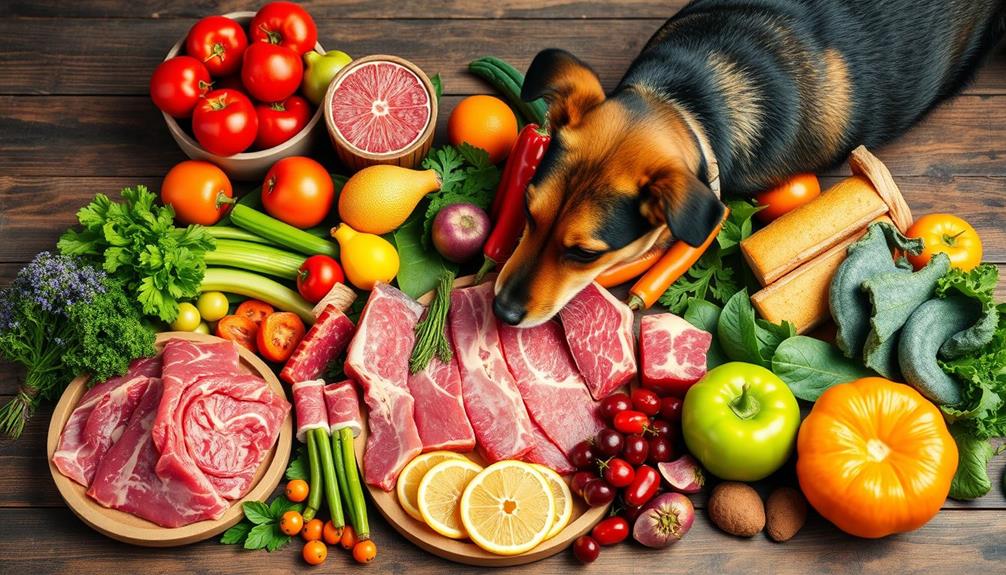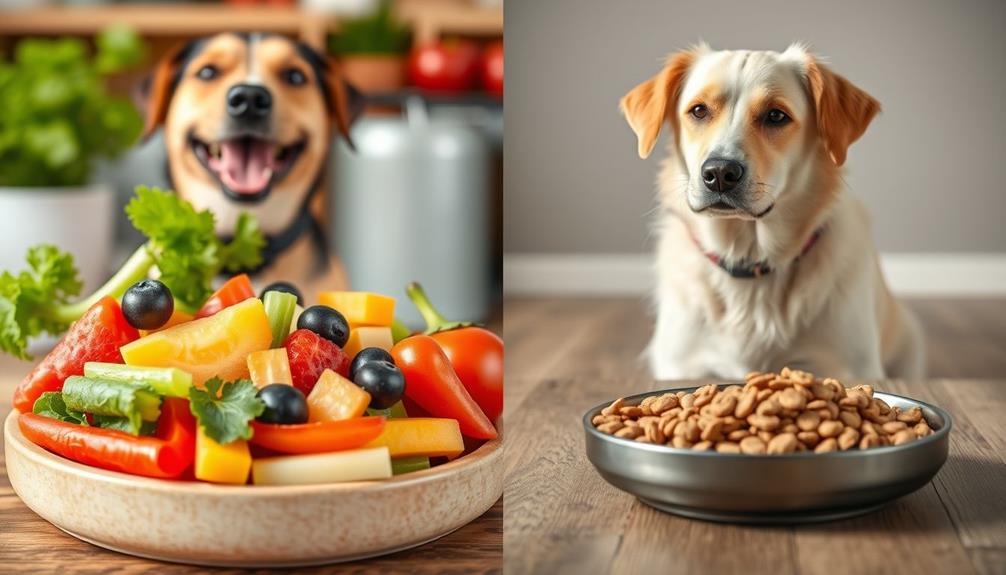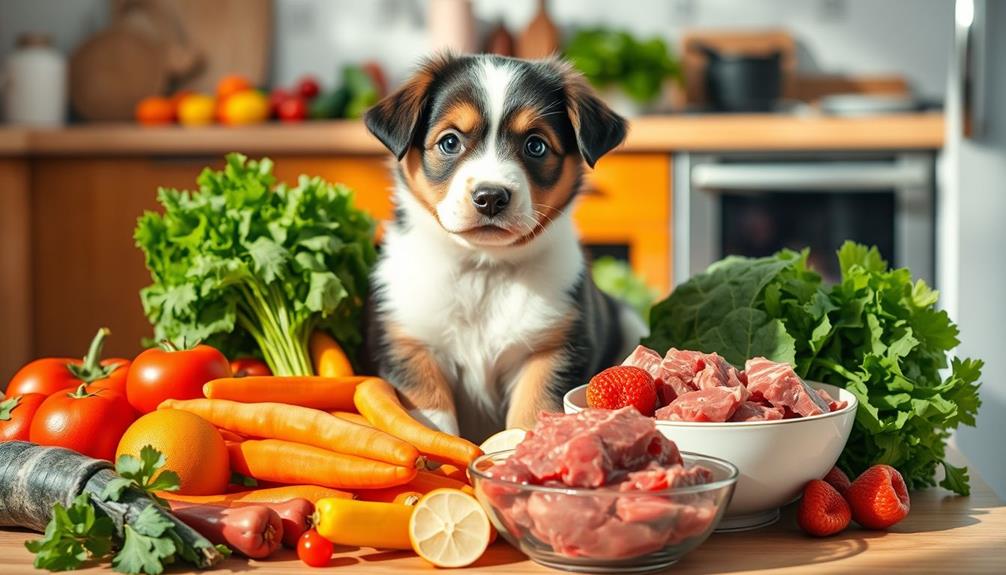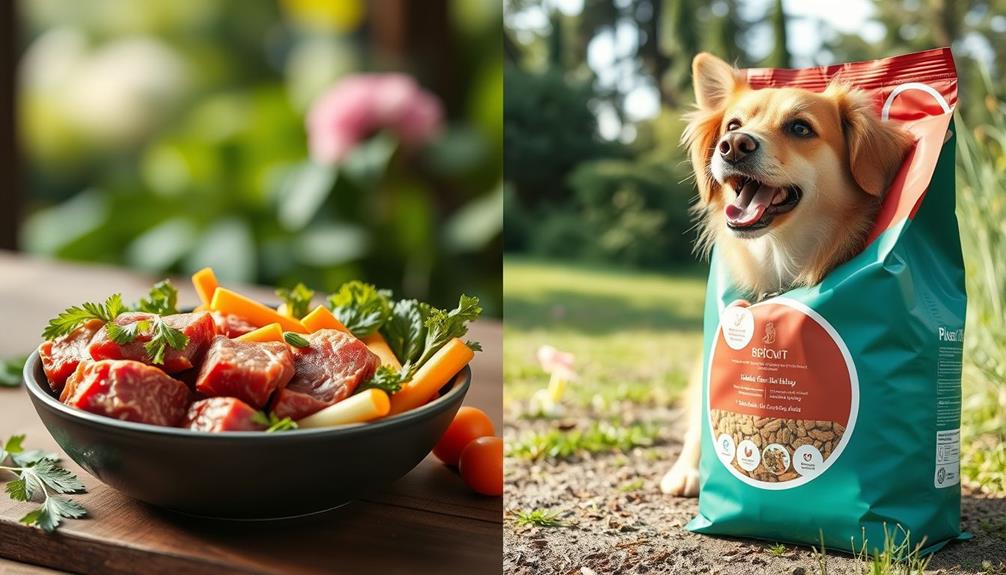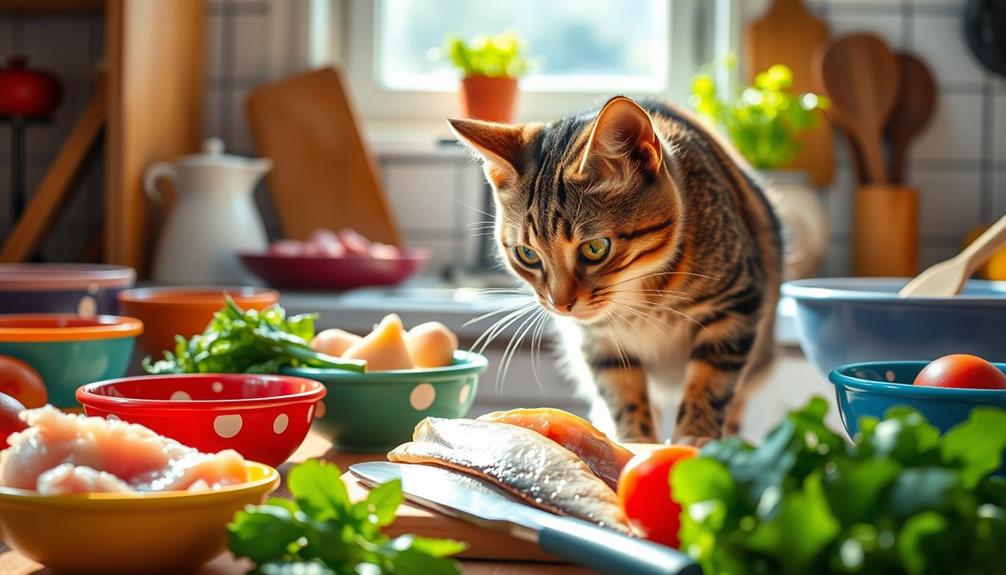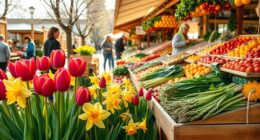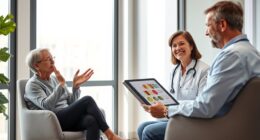Raw food diets can greatly enhance your dog's health and well-being. They provide high-protein nutrition, improving coat quality and energy levels while supporting ideal digestion. You'll see a reduction in gastrointestinal issues and better stool quality, too. Raw diets also help lower allergy risks by using high-quality, identifiable ingredients, resulting in fewer allergic reactions. Plus, the nutrient-dense components promote healthier skin and assist with weight management. By aligning with your dog's natural dietary needs, raw food can lead to better overall health. Stick around, and you'll uncover even more benefits of switching to a raw diet for your furry friend.
Key Takeaways
- Raw diets improve nutrient absorption, aligning with dogs' natural digestive systems, leading to better overall health and reduced gastrointestinal issues.
- Enhanced skin and coat health is reported, with essential fatty acids promoting shine and reducing conditions like canine atopic dermatitis.
- High-protein, low-carb options support effective weight management, helping dogs feel full while maintaining a healthy metabolism.
- Improved stool quality with smaller, firmer stools and less odor indicates better digestive health with fewer allergic reactions reported.
- Raw diets eliminate fillers and artificial ingredients, reducing digestive stress and enhancing the immune system's ability to combat allergens.
Raw Diet Overview
The allure of a raw diet for dogs lies in its promise of enhanced health and energy. As you explore the world of raw feeding, you'll discover that this natural diet consists of raw meat-based ingredients, bones, fruits, and vegetables, closely resembling the ancestral eating habits of canines.
Proper nutrition is essential, similar to how hamster care and costs emphasizes a balanced diet for small pets. Introduced by veterinarian Ian Billinghurst in 1993, the BARF diet—Bones and Raw Food or Biologically Appropriate Raw Food—highlights the benefits of a high-protein diet for dogs.
Switching to a raw diet can lead to several health benefits for your furry friend. You may notice improved coat quality, as the nutrients in raw foods promote a shiny, healthy appearance.
The natural chewing of bones also contributes to better dental health, reducing plaque buildup. Additionally, dogs on a raw diet often exhibit increased energy levels, making them more playful and active.
Benefits for Digestive Health
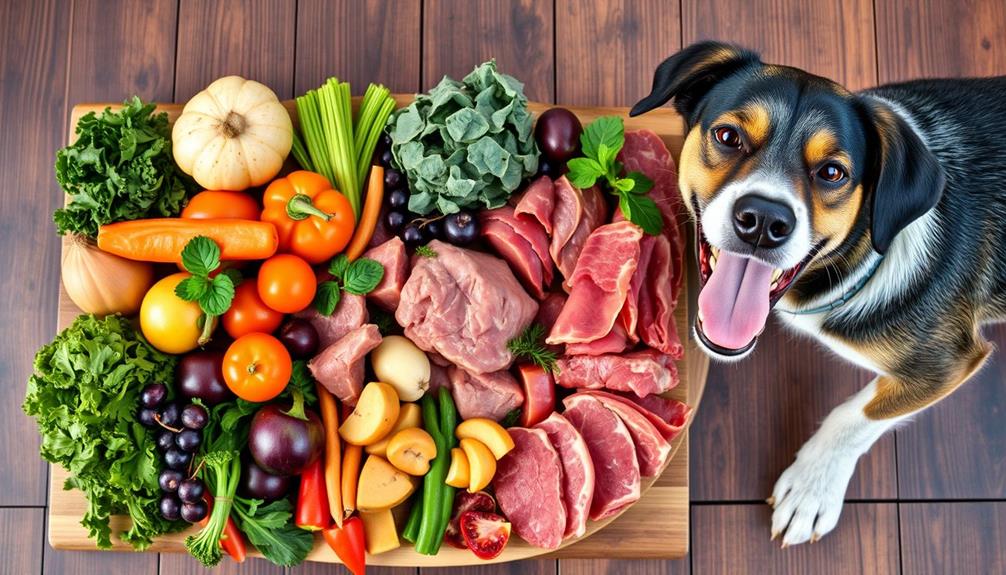
When you switch your dog to a raw diet, you'll likely notice enhanced nutrient absorption and improved stool quality.
This diet aligns with your dog's natural digestive system, reducing digestive stress and promoting overall gut health.
Additionally, incorporating a balanced approach to their diet can support overall health benefits, such as important lifestyle factors that contribute to longevity.
Many owners report fewer gastrointestinal issues and firmer stools after making the change.
Enhanced Nutrient Absorption
Raw diets greatly enhance nutrient absorption, capitalizing on dogs' natural digestive systems that are designed for processing raw meat. With shorter digestive tracts and higher stomach acidity, your dog can efficiently digest raw dog food, leading to improved gastrointestinal health. This means less digestive stress and better nutrient utilization, which ultimately translates to better overall health outcomes.
| Feature | Raw Dog Food Benefits | Impact on Dogs |
|---|---|---|
| Nutrient Absorption | Enhanced nutrient absorption | Supports overall health |
| Digestive Stress | Reduced digestive stress | Especially for sensitive stomachs |
| Stool Quality | Smaller, firmer stools | Indicates efficient digestion |
Improved Stool Quality
Experiencing improved stool quality is one of the most noticeable benefits of a raw food diet for dogs. Many owners report that their pets produce smaller, firmer stools, which is a significant improvement over commercial dry food.
Additionally, incorporating natural ingredients can align with dogs' nutritional needs, similar to how essential oils for digestive support can enhance overall wellness. Here are some key points to evaluate:
- Healthier Stools: Raw diets contribute to better gut health, leading to stools that aren't only firmer but also less odorous.
- Less Frequent Bowel Movements: With efficient digestion and nutrient absorption, raw-fed dogs tend to have fewer bowel movements compared to those on dry kibble.
- Digestive Stress Reduction: The natural ingredients in raw diets align with dogs' digestive systems, reducing stress on their digestive tracts.
- Enhanced Nutrient Absorption: The bioavailability of nutrients in raw food supports better digestion, resulting in healthier stools.
Reduced Digestive Stress
Many dog owners notice that their pets experience considerably reduced digestive stress when changing to a raw food diet. This is largely due to dogs' short digestive tracts and high stomach acidity, which are better suited for raw meat consumption.
Additionally, the absence of fillers and artificial ingredients in raw diets can lead to fewer digestive issues, making it a better option for digestive health. Raw food diets improve nutrient absorption, leading to smaller, firmer stools and enhanced overall digestive health compared to those on commercial dry food.
For dogs with sensitive stomachs, raw diets can greatly reduce gastrointestinal upset and promote ideal nutrient utilization. Many owners report that their dogs show less digestive discomfort after altering to raw. In fact, 96% of dog owners note improved stool quality after making the switch, highlighting the benefits of raw food for digestive health.
The bioavailability of nutrients in raw food plays an essential role in supporting dogs with existing digestive issues. By providing easily digestible and nutrient-rich meals, raw diets help guarantee your dog thrives while minimizing digestive stress.
If you're looking to improve your dog's digestive health and overall well-being, consider the advantages of a raw food diet. Your furry friend might just thank you with wagging tails and happier days!
Allergy Reduction Factors
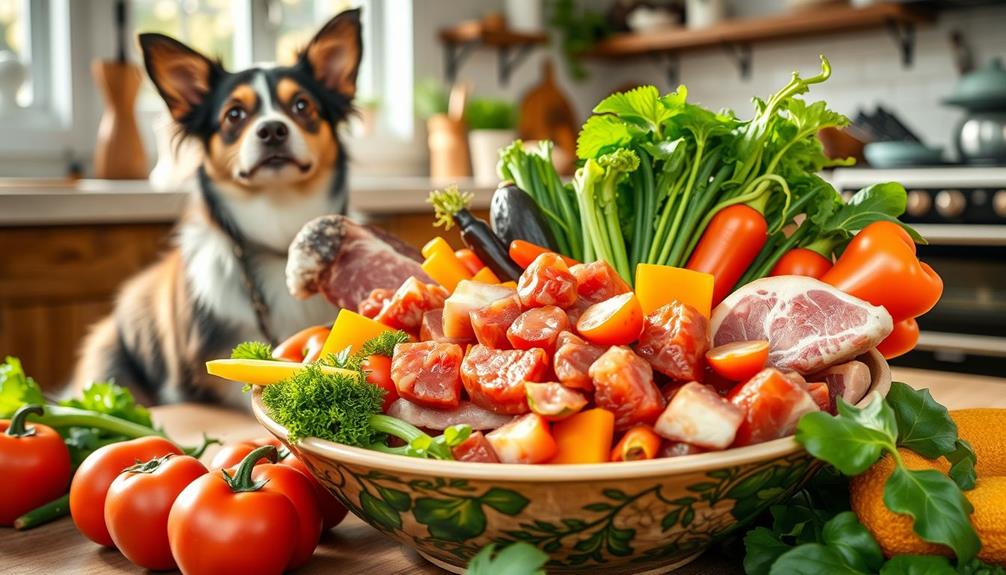
Switching to a raw food diet can markedly lower your dog's chances of developing allergies. By opting for a raw diet for dogs, you can address several allergy reduction factors that are often overlooked in commercial pet foods.
Additionally, incorporating high-quality protein sources, such as lamb, can enhance your dog's energy levels and overall health, while healthy dog snacks can provide a great supplement to their diet.
Here are four key benefits:
- High-Quality Proteins: Raw diets are rich in high-quality proteins that bolster your dog's immune system, helping them manage allergens more effectively.
- Grain-Free Options: Many raw diets are naturally grain-free, reducing inflammatory responses linked to food allergies and related health problems.
- Identifiable Ingredients: With real, recognizable ingredients, it's easier for you to pinpoint specific allergens, making it simpler to avoid known sensitivities.
- Reduced Allergic Reactions: Owners report fewer allergic reactions, such as itching, vomiting, and diarrhea, after switching from traditional commercial pet foods.
Skin and Coat Improvements
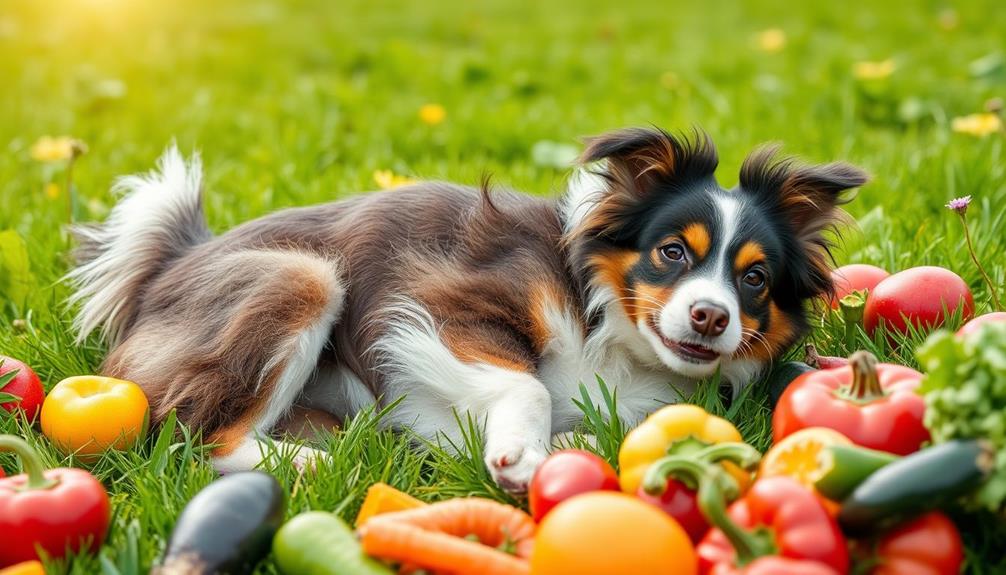
A shiny, vibrant coat is often a reflection of your dog's overall health, and a raw food diet can greatly enhance skin and coat improvements. Many dog owners who switch to raw diets report healthier skin and coats, with 90% noting the benefits come from balanced nutrients found in these meals.
Understanding the significance of nutritional balance is essential when considering any diet for your pet.
Essential fatty acids, particularly omega-3 and omega-6, are key players in this transformation, promoting coat shine and softness. Additionally, raw diets have been linked to a reduction in canine atopic dermatitis, which can lead to improved skin health.
By minimizing allergic reactions, your pup can enjoy a more comfortable life, and their coat will reflect this newfound vigor.
Moreover, raw diets are packed with nutrient-dense ingredients that support ideal skin cell function. This means not only a healthier skin barrier but also a cleaner and more vibrant coat appearance.
With improved gut health from raw feeding, you'll notice fewer issues that can negatively impact your dog's coat.
Weight Management Solutions
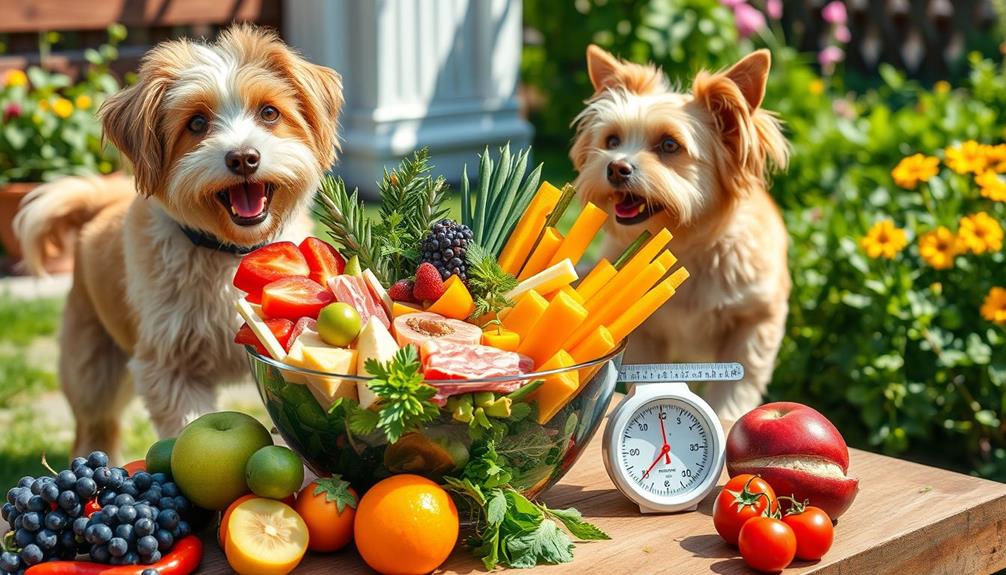
When it comes to weight management for your dog, nutrient-dense ingredients are key.
By focusing on high-protein, low-carb options, you can help your pup feel full while keeping calories in check.
Incorporating these common financial terms can also apply to budgeting for your pet's food.
Plus, practicing portion control guarantees that your dog enjoys their meals without the risk of overeating.
Nutrient-Dense Ingredients
Many dog owners are discovering the incredible benefits of raw food diets, particularly when it comes to weight management.
The nutrient-dense ingredients in these diets play a crucial role in supporting your dog's health and ideal body condition. Additionally, raw foods can be advantageous in preventing certain health issues, such as obesity, which is linked to high carbohydrate levels in many commercial dog foods the impact of carbohydrate levels.
Here are four key aspects to evaluate:
- High Protein Content: A raw diet is rich in protein, which helps maintain muscle mass and boosts energy levels, enabling your dog to stay active.
- Essential Vitamins and Minerals: Raw foods are packed with vitamins and minerals that promote overall health and prevent deficiencies.
- Low Carbohydrate Levels: These diets typically contain lower carbohydrates, reducing the risk of obesity and related health issues.
- Species-Appropriate Ingredients: Raw diets use ingredients that align with your dog's natural dietary needs, helping to prevent obesity risks associated with many commercial foods.
Portion Control Importance
Effective portion control is vital for maintaining your dog's ideal weight, especially when shifting to a raw food diet. Raw diets are typically lower in carbohydrates and higher in protein, which helps promote weight loss and maintain a lean body condition.
By focusing on nutrient-dense foods, you can offer smaller portion sizes that still meet your dog's energy needs, effectively preventing obesity linked to overfeeding. Additionally, understanding key domains of development can help you recognize how dietary changes can impact your dog's overall health and behavior.
Regular monitoring of your dog's food intake is significant. Studies show that 90% of raw diet customers report their dogs maintain a healthy weight, highlighting the importance of portion control.
The palatability of raw diets can also boost mealtime excitement, encouraging your dog to enjoy their meals without the urge to overeat.
To optimize weight management, adjust portion sizes based on your dog's activity level and individual needs. This proactive approach guarantees your dog remains healthy while enjoying the benefits of a raw diet.
Nutritional Insights
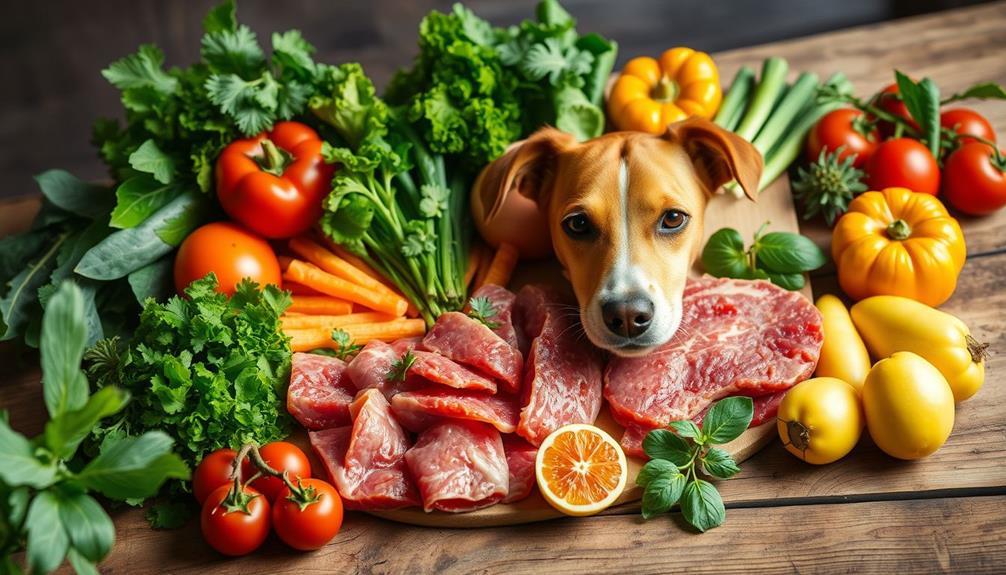
How can a raw food diet transform your dog's health? By embracing a raw diet, you reveal a treasure trove of nutritional benefits that can enhance your dog's well-being.
Raw diets can also inspire pet owners to explore various ingredients, much like coffee enthusiasts investigate different coffee varieties. Here are four key insights:
- Bioavailable Nutrients: Raw diets are rich in nutrients that improve nutrient absorption and support ideal digestive health.
- Protein Sources: Higher protein and fat content in raw food provides efficient energy sources, boosting your dog's energy and muscle tone.
- Vitamins and Minerals: Essential vitamins and minerals in raw diets bolster immune function, helping your dog fend off illnesses and maintain overall health.
- Healthier Skin and Coat: Nutrient-dense raw ingredients, including omega fatty acids, promote healthier skin and coat conditions, reducing allergies and irritations.
When you choose a biologically appropriate raw diet, you're not just feeding your dog; you're providing a foundation for better health.
Improved digestive health leads to smaller, firmer stools, and the right balance of nutrients enhances your dog's energy levels.
With these benefits, it's clear that a raw food diet can be a game-changer for your furry friend.
Safety Considerations
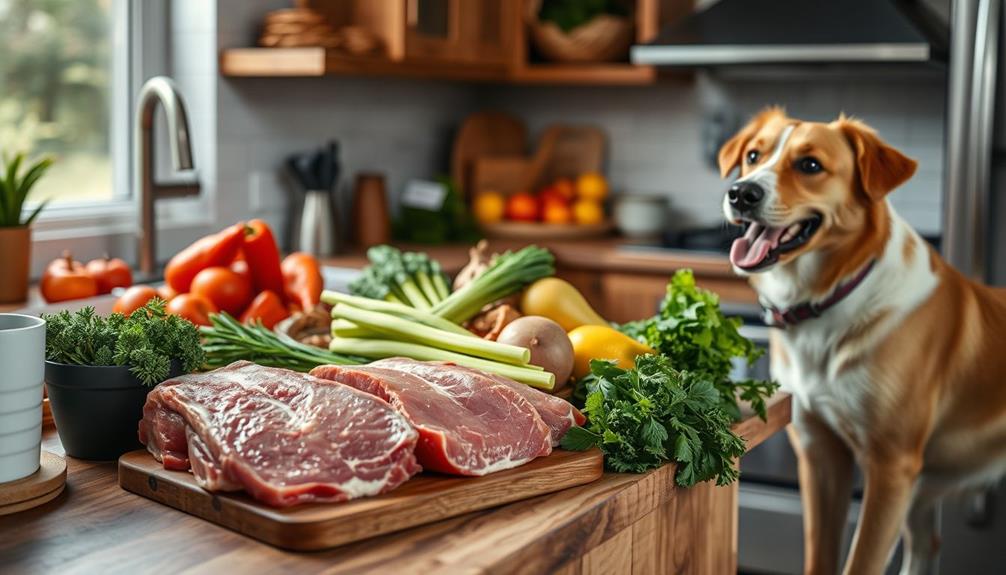
While a raw food diet can offer numerous health benefits for your dog, it also comes with significant safety considerations that pet owners must keep in mind. One of the primary concerns is bacterial contamination, which can pose considerable health risks to both pets and humans. Proper handling and hygiene are indispensable to minimize these dangers.
Always wash your hands before and after handling raw food, and make certain that all surfaces and utensils are clean. To avoid cross-contamination, designate specific bowls and utensils for raw food preparation and feeding. This practice helps guarantee that raw ingredients don't come into contact with other foods in your household.
If you're concerned about pathogens in raw pet food, consider options that use high-pressure processing (HPP). This method effectively kills harmful bacteria without compromising nutritional quality, providing safer choices for pet owners.
It's especially important for households with vulnerable individuals, like young children or immunocompromised members, to exercise caution. Weighing these safety precautions against the benefits of a raw diet is essential for making informed decisions about your dog's nutrition.
Veterinary Perspectives
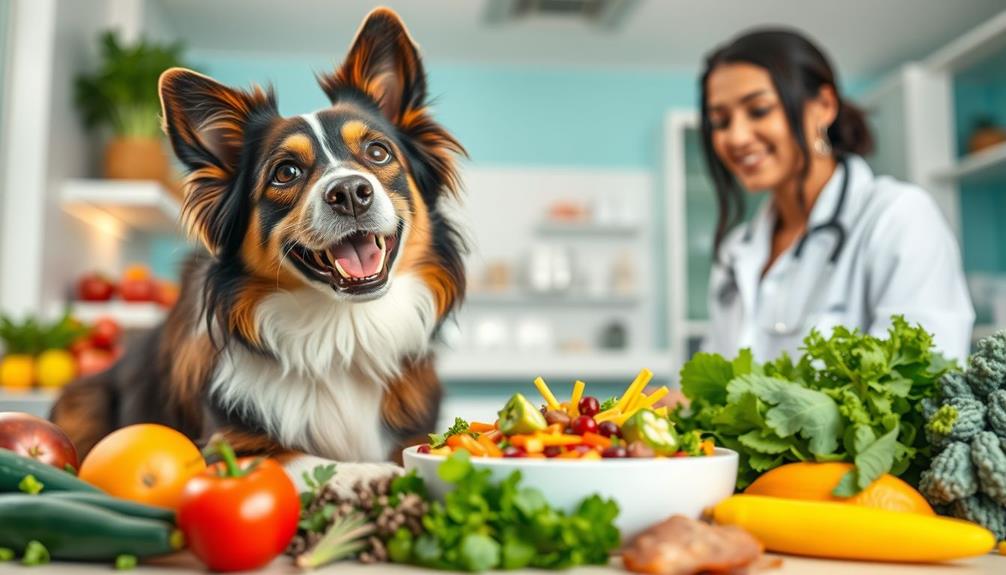
Veterinary perspectives on raw food diets for dogs often bring to light a mix of skepticism and emerging understanding. While many veterinarians voice concerns about nutritional imbalances and health risks associated with bacteria, some studies suggest raw diets can actually enhance your dog's overall well-being.
Here are four key points to take into account:
- Coat Quality: Improved coat appearance is frequently reported by raw diet advocates.
- Immune Function: Raw diets may bolster your dog's immune system thanks to bioavailable nutrients.
- Digestive Health: Enhanced gut flora from raw feeding can contribute to better digestive health.
- Energy Levels: Many dog owners notice increased vitality in their pets on a raw diet.
Despite the skepticism from organizations like the AVMA, some veterinarians are starting to acknowledge these potential benefits.
A gap in nutritional expertise among veterinarians often leads to misinformation about raw feeding, as many have limited training in specialized pet nutrition.
As emerging research continues to validate the claims made by raw diet proponents, it's essential for pet owners to engage in informed discussions with their veterinarians about the best dietary choices for their dogs.
Frequently Asked Questions
What Are the Benefits of Raw Food for Dogs?
Raw food offers numerous benefits for your dog. You'll notice improved skin and coat health, better stool quality, weight management, and enhanced dental health. Plus, it can boost overall energy and potentially extend your pet's lifespan. When considering a raw food diet for dogs, it’s important to consult with your veterinarian to ensure that your pet’s nutritional needs are being met. It’s also crucial to follow safe food handling practices to minimize the risk of bacterial contamination. With the right guidance and precautions, a raw food diet for dogs can be a beneficial and enjoyable option for your furry companion.
Is Raw Food Actually Better for Dogs?
Is raw food actually better for dogs? You'll find that many pet owners swear by it, claiming improved health, shinier coats, and better digestion. Why not explore the benefits and see if it suits your pup?
What Do Vets Say About Raw Dog Food?
Vets express mixed feelings about raw dog food. Some caution against nutritional imbalances and bacteria risks, while others note potential benefits for specific health issues. Always consult your vet before making dietary changes for your dog.
What Are the Benefits of Eating More Raw Food?
Imagine your dog as a wild wolf, thriving on natural nourishment. By feeding them more raw food, you'll boost their energy, improve digestion, enhance skin and coat health, and help maintain a healthy weight.
Conclusion
Incorporating a raw food diet for your dog could open up a world of health benefits you never imagined. As you witness improvements in digestion, skin, and even weight management, you might wonder—what else could this diet do? The excitement builds as you explore the nutritional insights and safety measures, all while keeping your furry friend thriving. Are you ready to take the plunge and discover the transformative power of raw food? The journey starts now.

